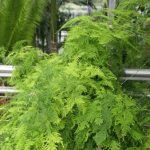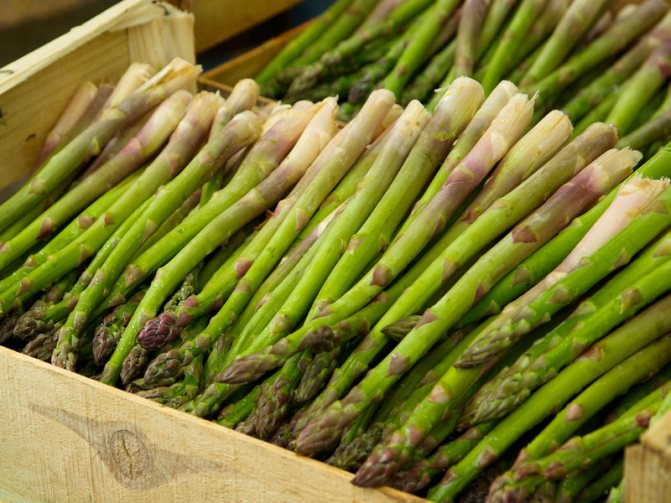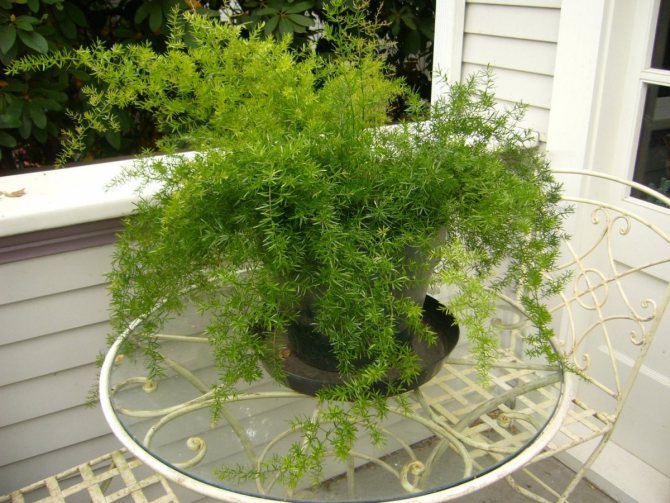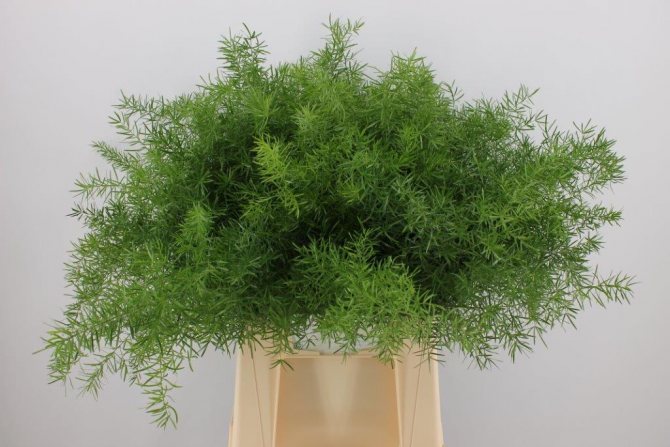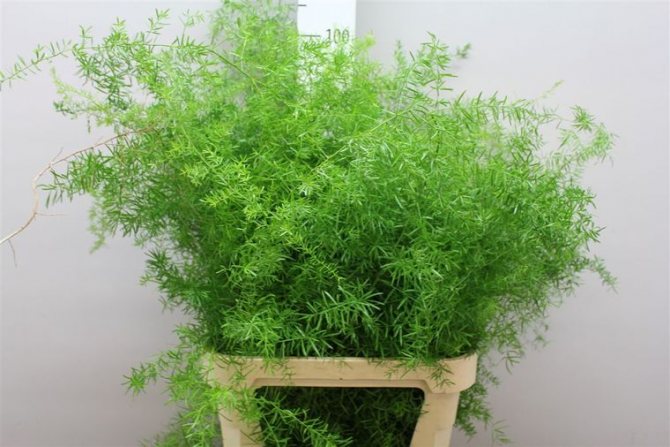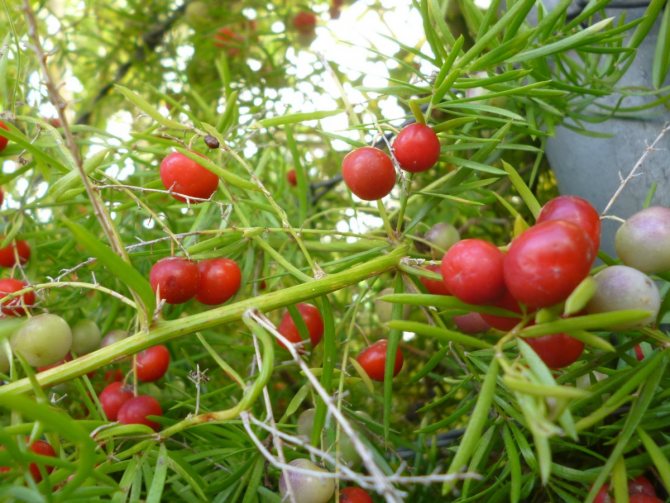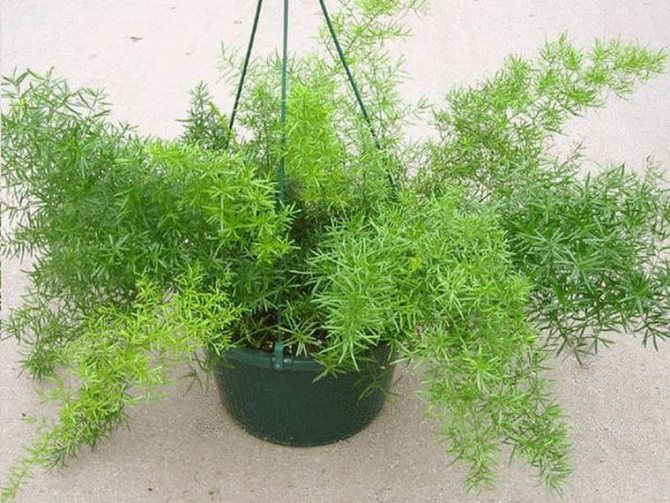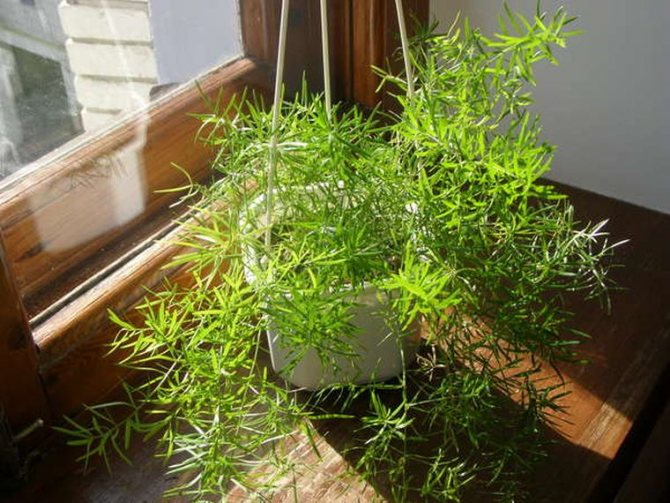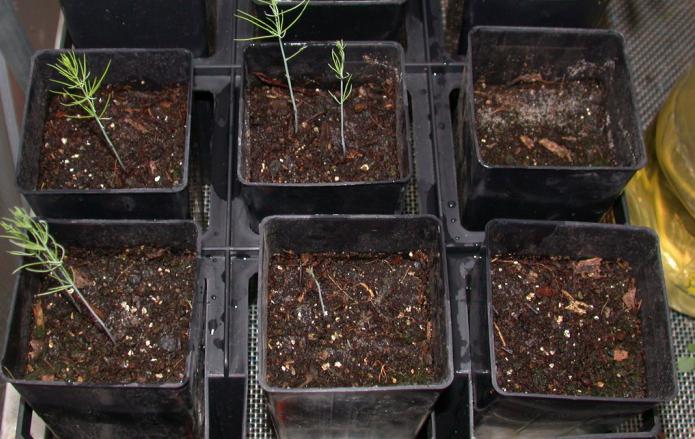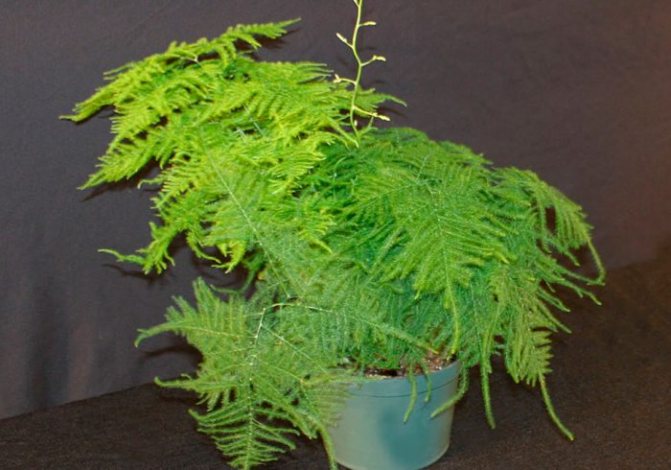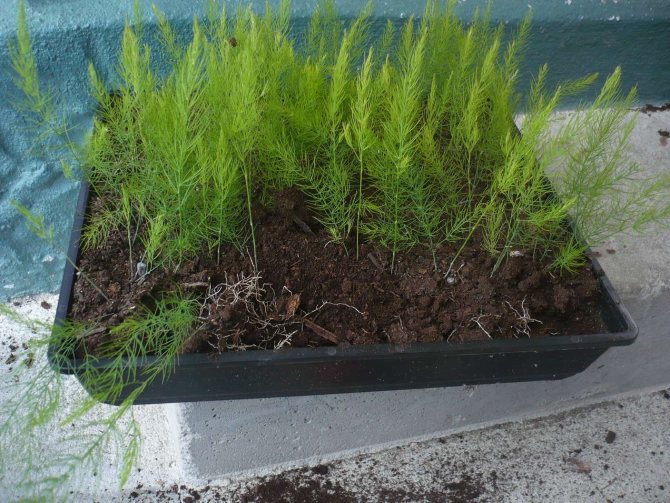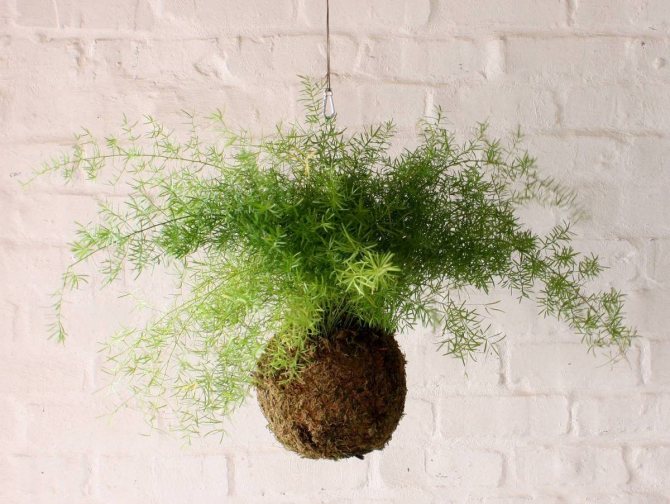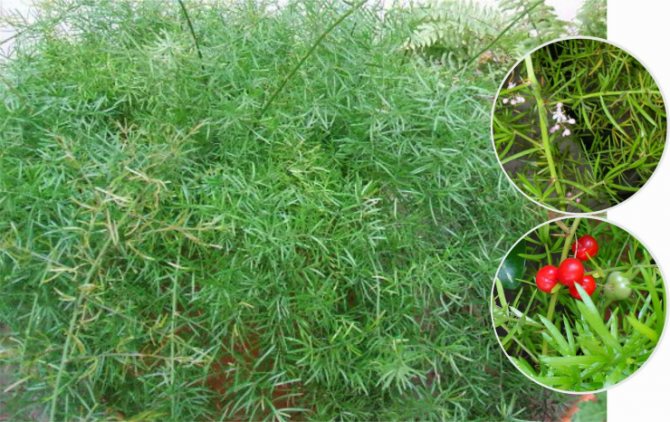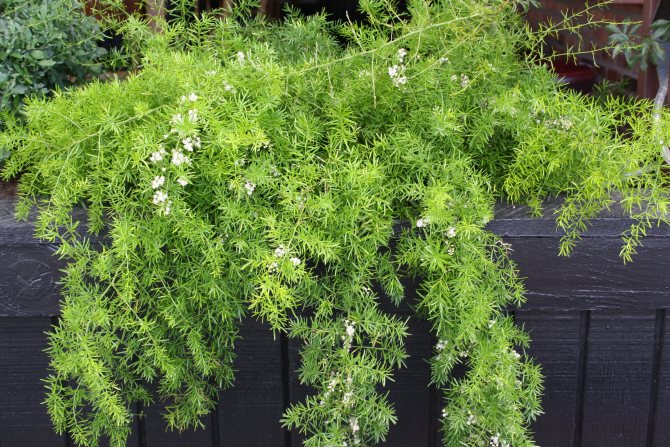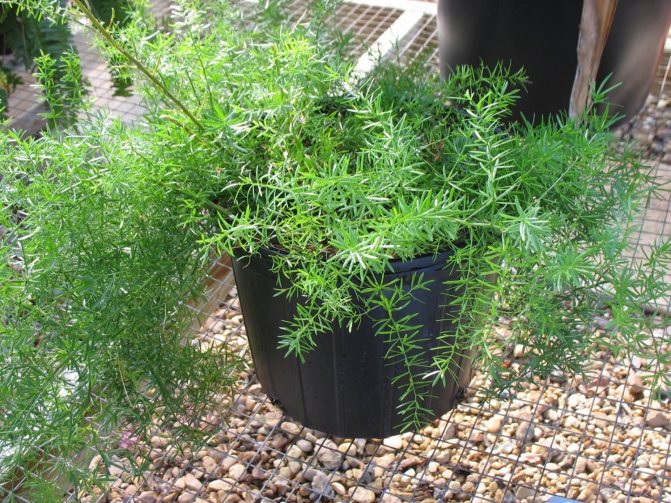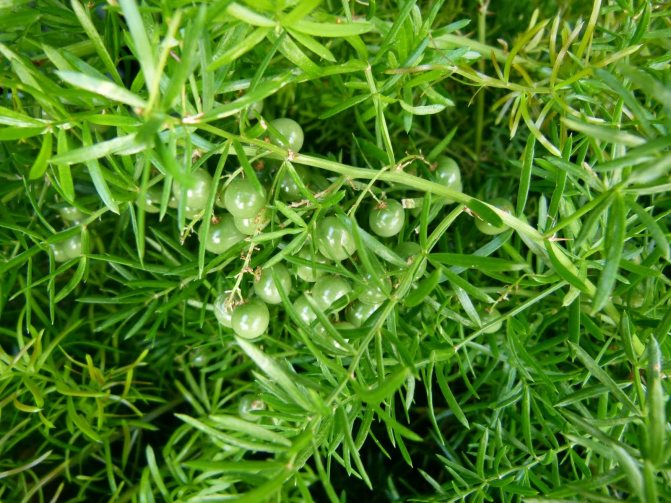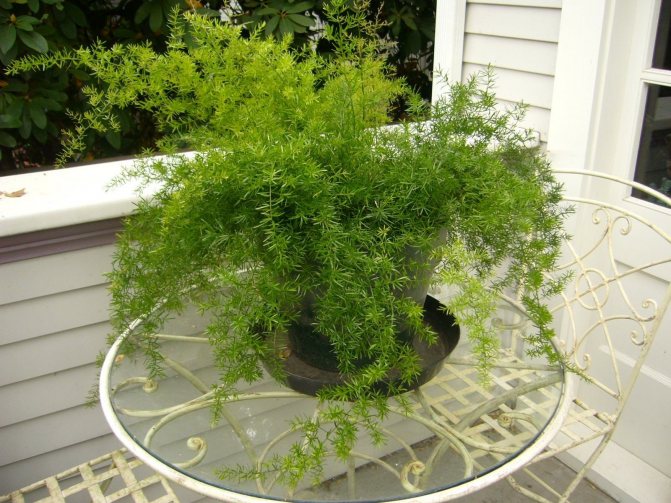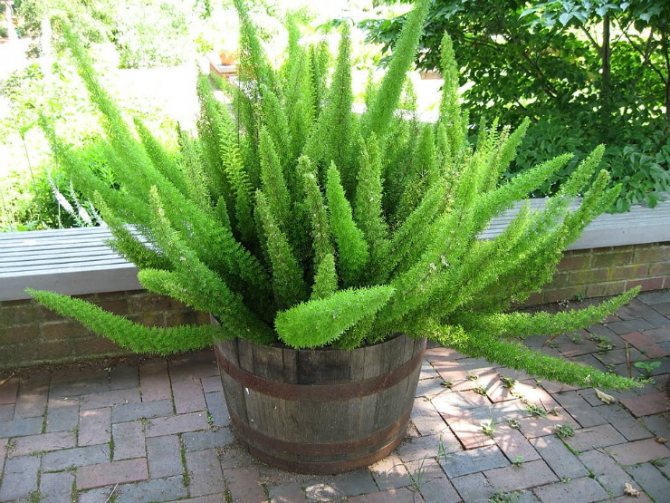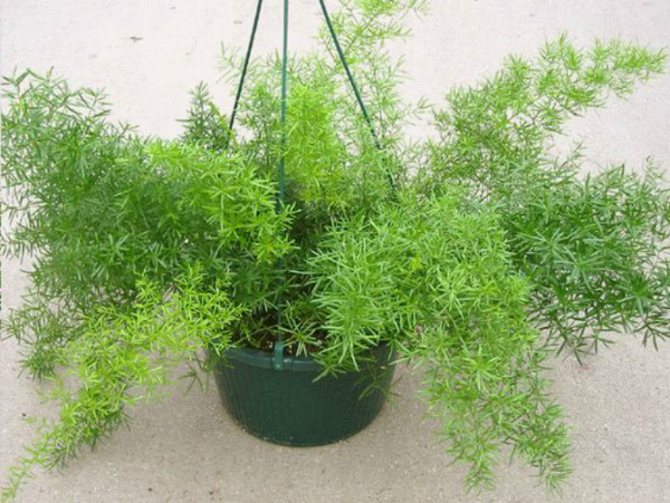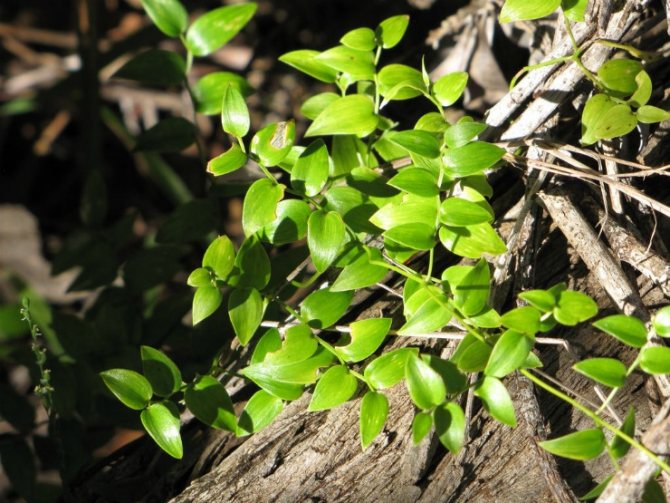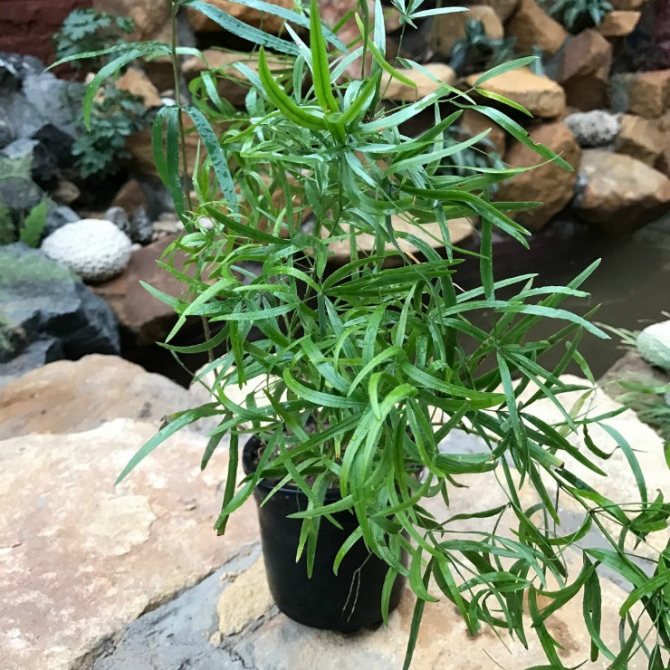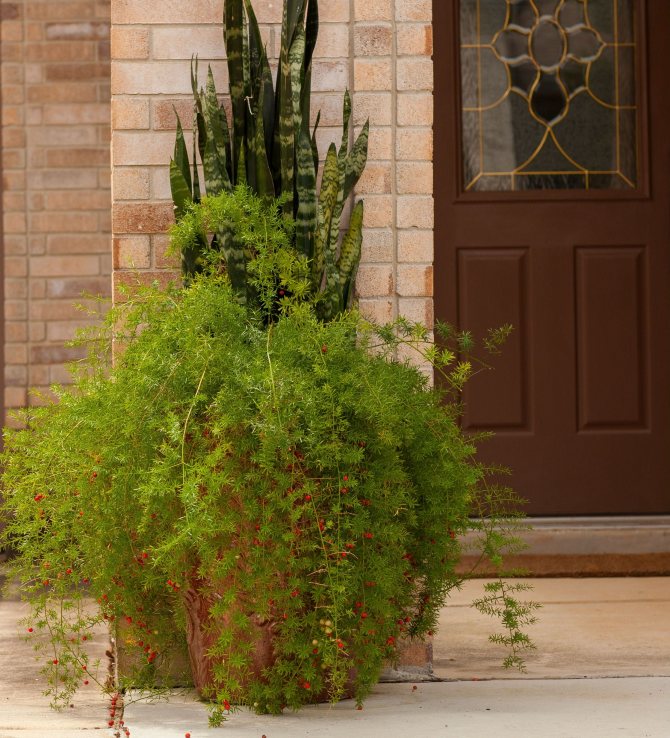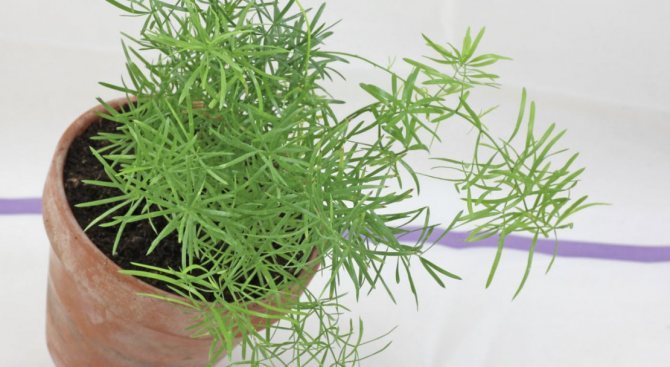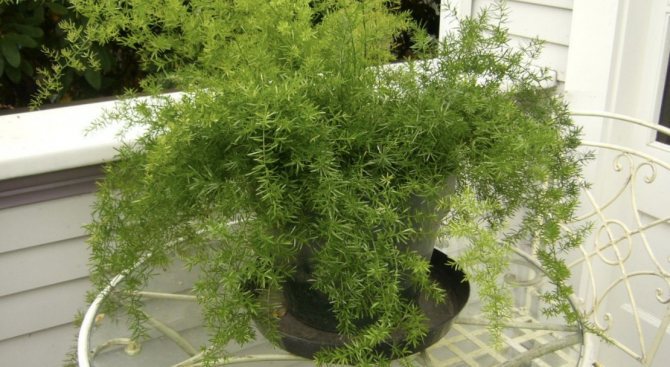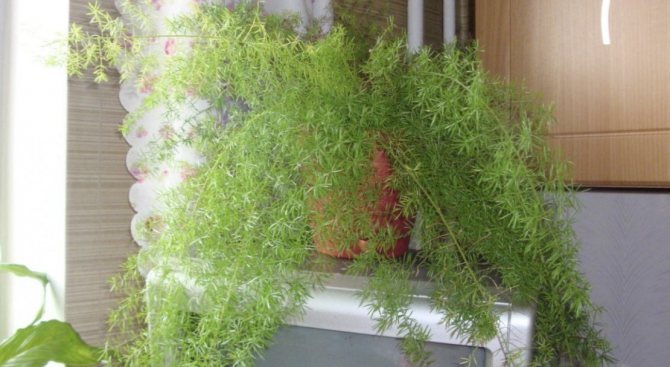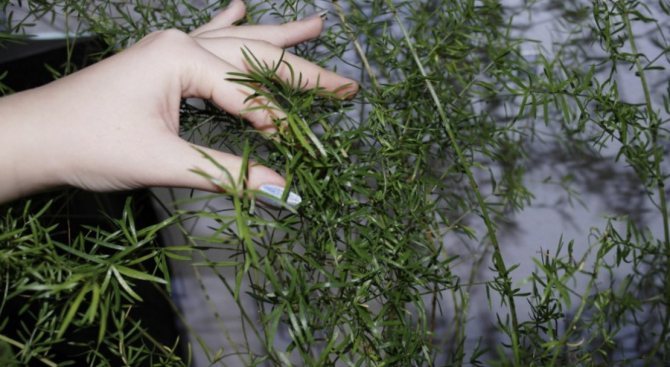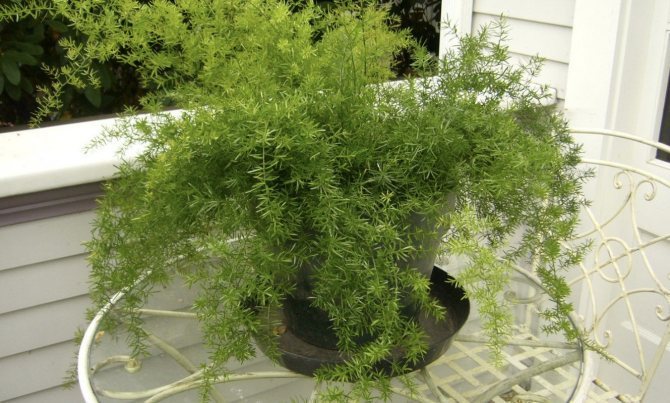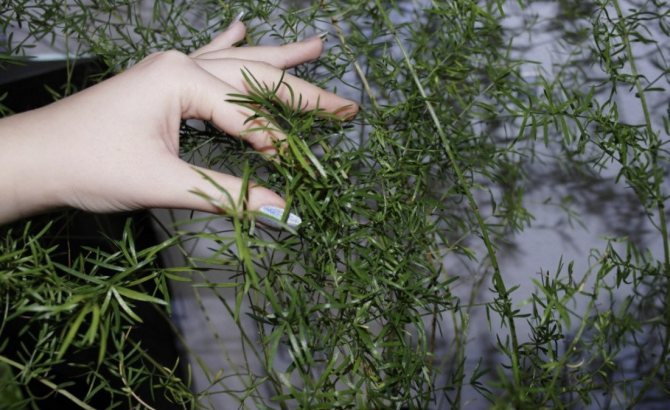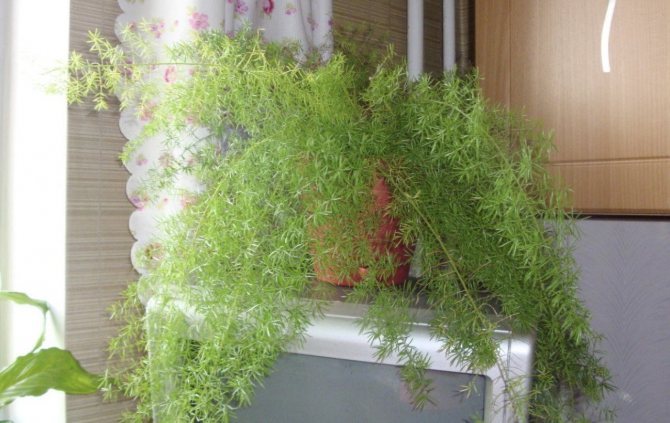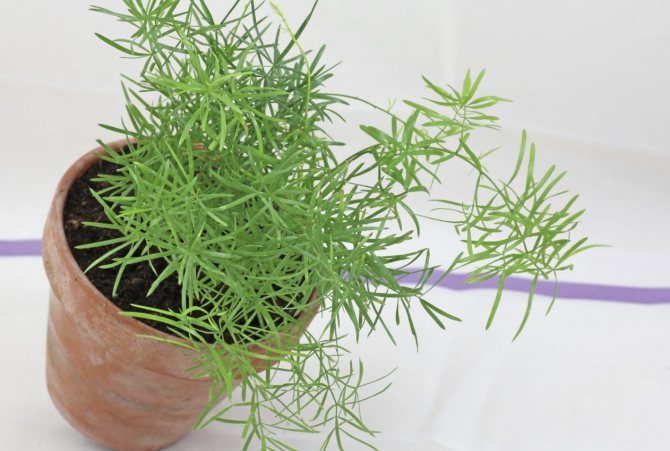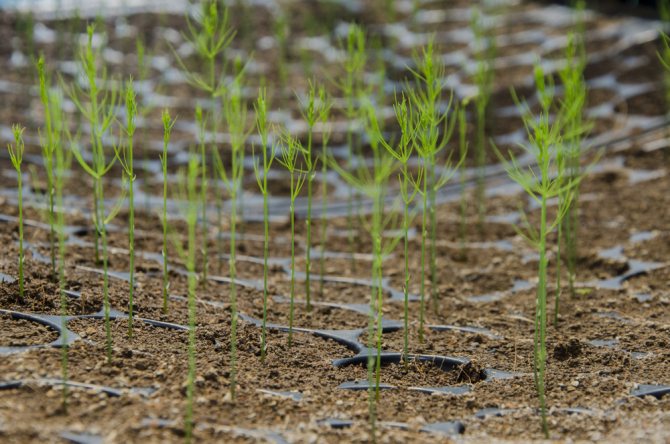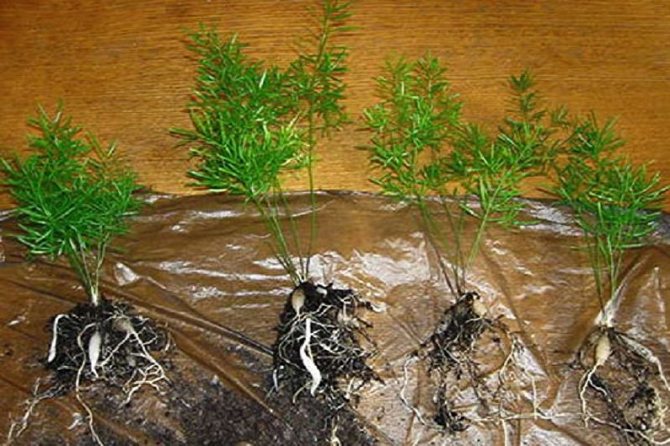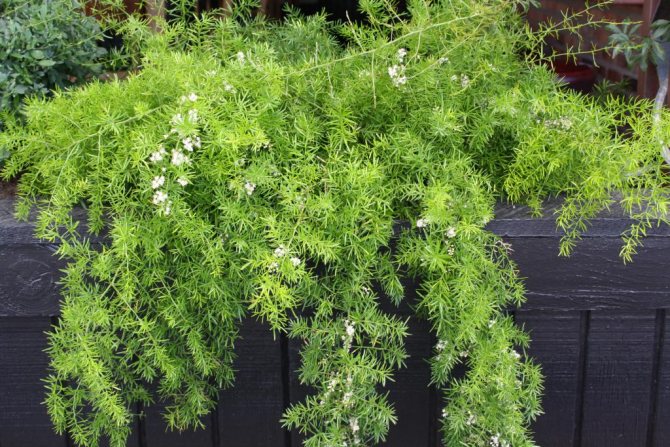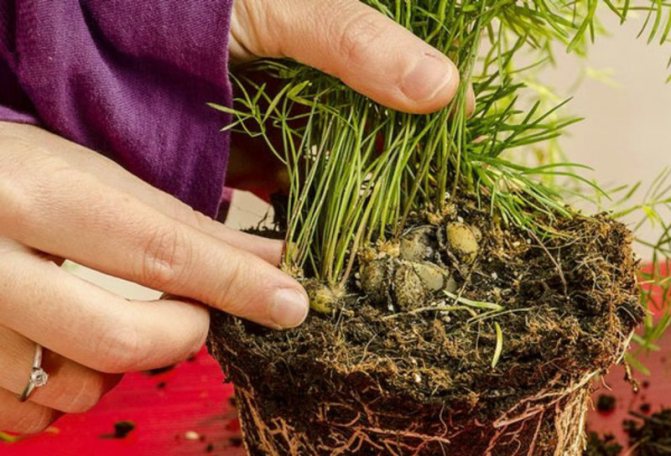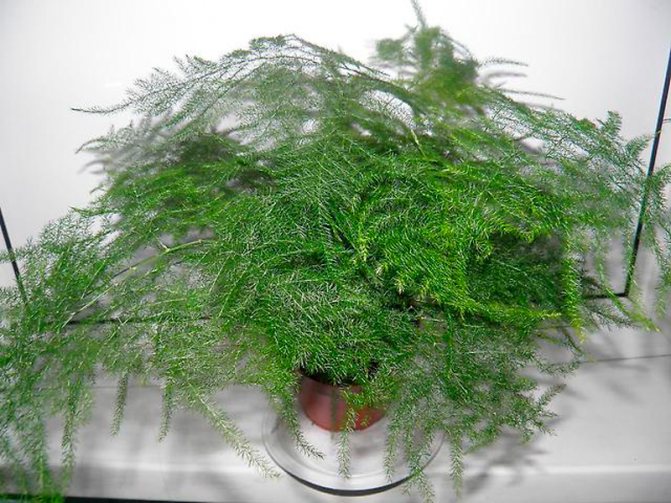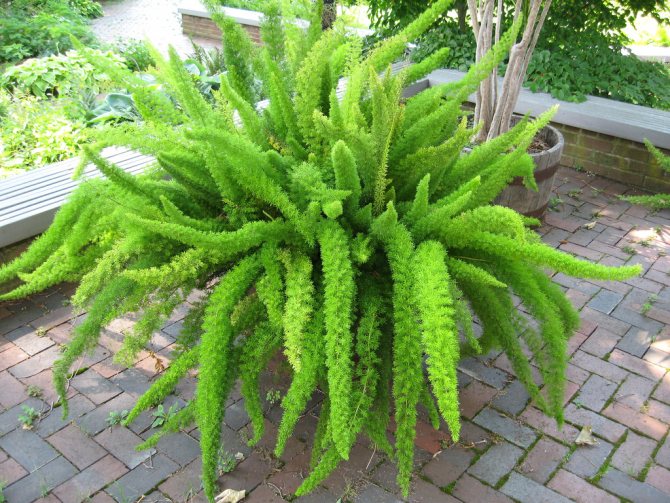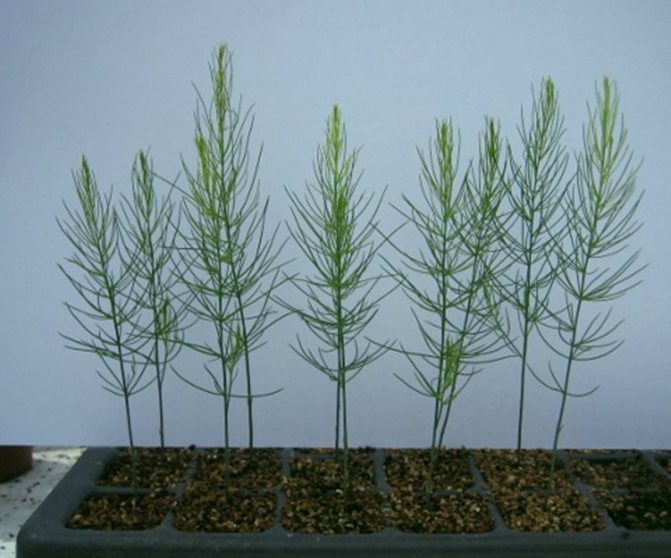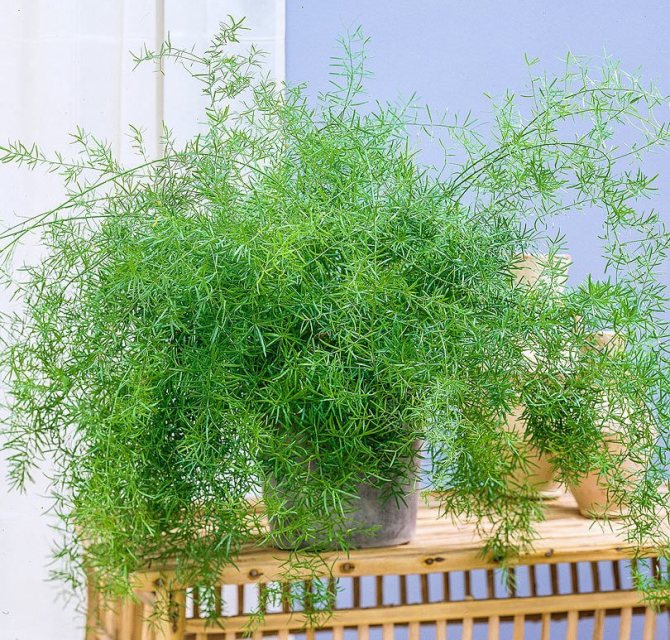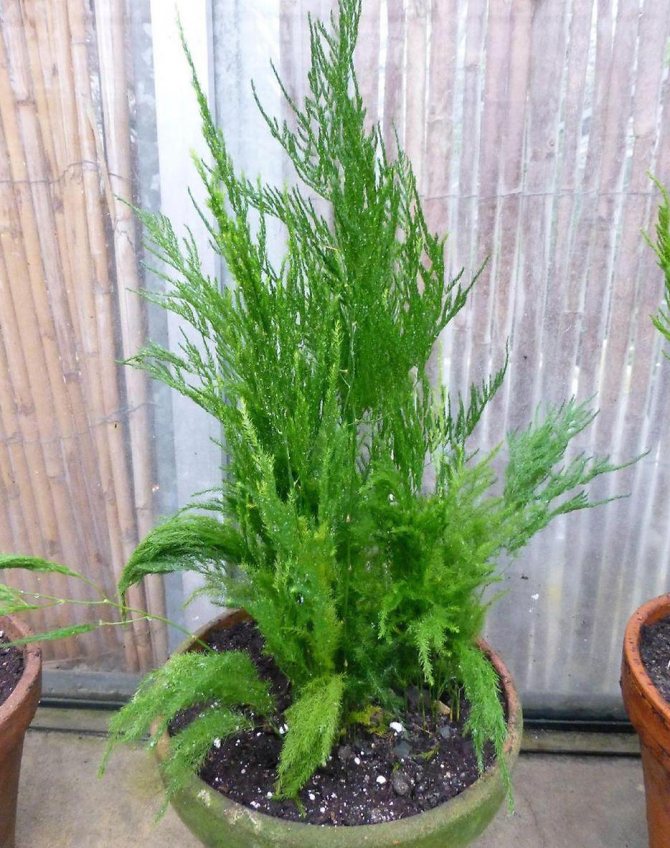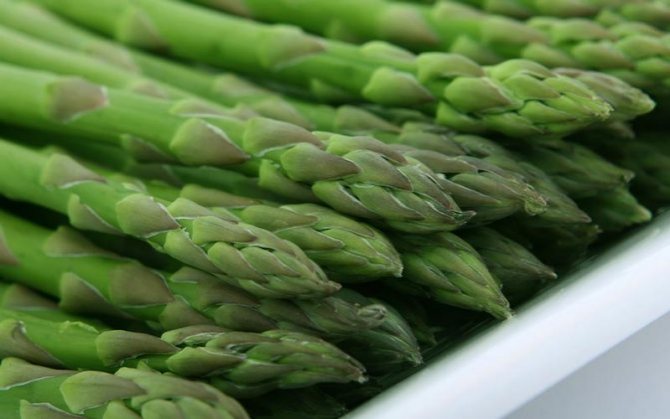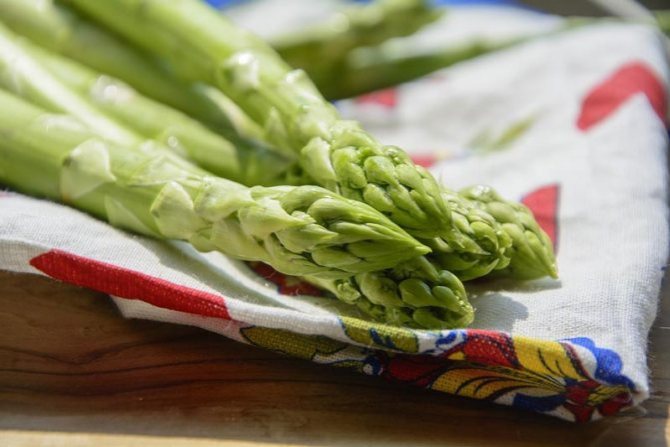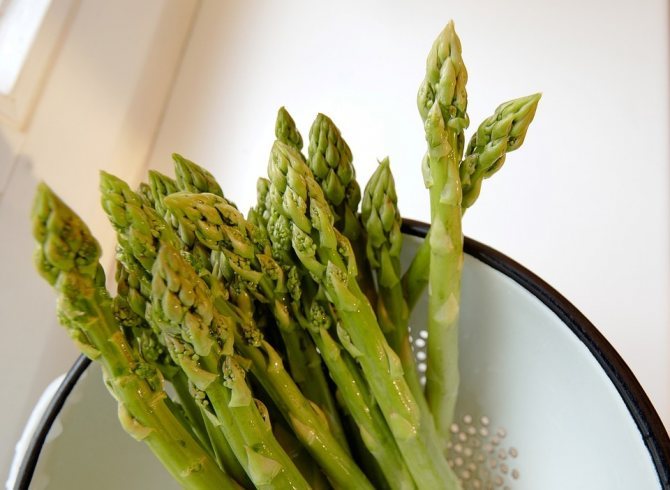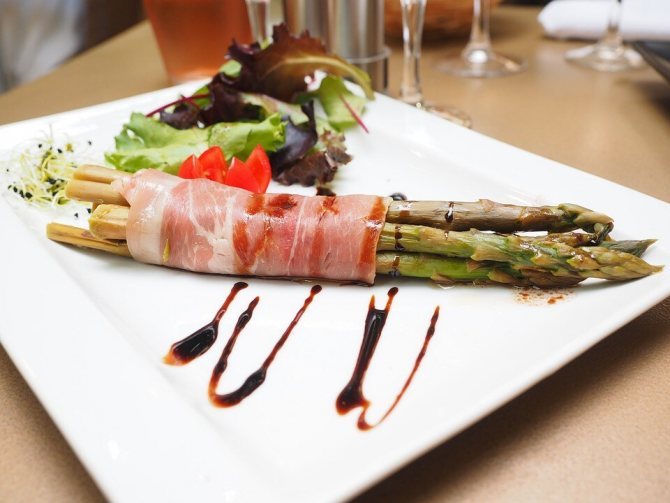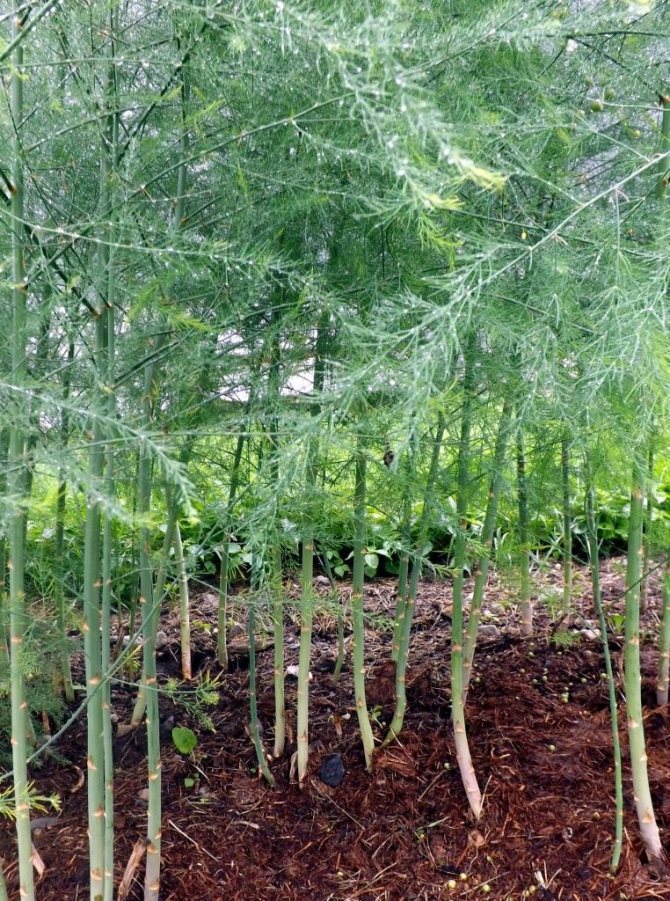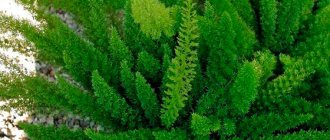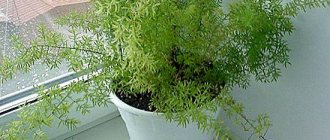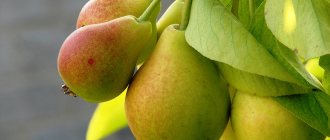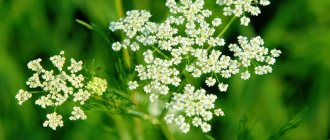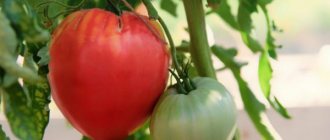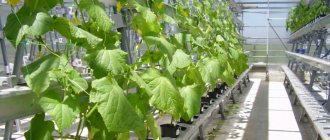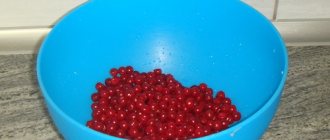It is grown in the form of a shrub or liana, depending on the variety. The length of the vine can reach one and a half meters. The root is powerful and long, rod-shaped, inconspicuous flowers of pink or white are collected in discreet inflorescences. Fruits that ripen after flowering can be used for propagation.
Attention! The plant contains poison, contact with small children and animals can end in failure.
| High growth rate, up to 15 new leaves in one season |
| In indoor conditions, liana blooms very rarely. |
| The plant is easy to grow. |
| Perennial. |
Botanical description of the plant
Asparagus sprenger includes over 250 subspecies that are found in subtropical climates around the world. They are perennial grasses, shrubs and vines. Refers to creeping ampelous varieties with a well-developed root system. Previously, asparagus was attributed to the lily family due to the shape of the flowers, a little later it was reclassified as asparagus.
Did you know? Under ideal growing conditions, asparagus shoots grow 20 cm per day.
How Sprenger's asparagus reproduces
There are three ways to plant Sprenger's asparagus:
- Separation of a part of the rhizome with active buds.
- Seeds.
- Cuttings.
Germinating seeds
Purchased grains or berries plucked from an already mature bush are suitable for seed propagation. Before planting, the seed is strengthened by soaking in a weak solution of potassium permanganate. Landing is carried out in this way:
- Seeds are planted in the prepared moist soil (the distance between them is about 3 cm).
- Cover the box with plastic wrap. This will help maintain the same temperature at all times.
- The greenhouse is periodically ventilated and sprayed with water.
Seedlings will appear after 18-25 days.
Rhizome division
Division is performed as follows:
- A part of the rhizome is separated from the mother bush, on which there must be several buds and shoots.
- Each individual piece of rhizome is planted in prepared and pre-moistened soil.
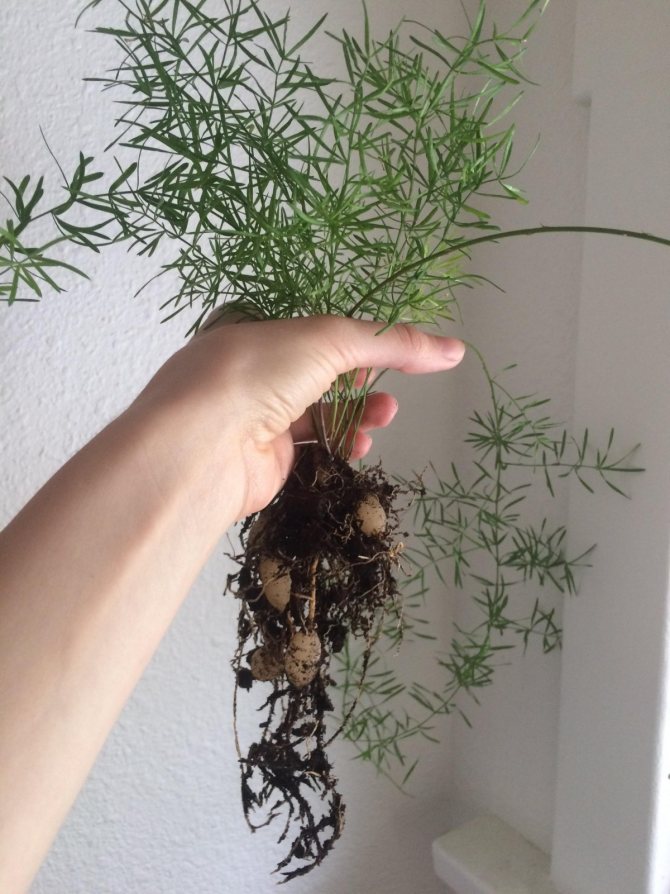
Propagation of asparagus by rhizome
Cuttings
To plant a flower in this way, follow several steps:
- In early spring, shoots are cut from the bush. The length of the cuttings should be 15-20 cm.
- Layers are dropped into wet sand. To preserve heat and moisture, the container is covered with a film and periodically ventilated.
- After the roots appear, the cuttings are planted in flowerpots.
3. Varieties:
3.1. Asparagus pinnate or bristle-like - Asparagus plumosus, Asparagus Setaceus
Evergreen, herbaceous, small-leaved plant with rigid, upright, green stems, the length of which can reach 1 m, but more often reaches 20 - 30 cm. At the tops of the stems there are numerous thin twigs with thin, straight, needle-like leaves in autumn.Branches with leaves resemble frond ferns. The flowers are bell-shaped, drooping, greenish; as they bloom, they turn into rounded black berries.
↑ Up,
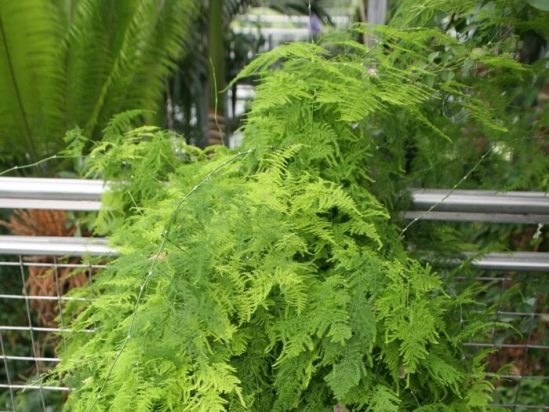

3.2. Asparagus dense-flowered Sprenger or Ethiopian - Asparagus densiflorus Sprengeri
Perennial herbaceous plants from 40 to 60 cm high with numerous green, thin, rigid, curved stems. The leaves are emerald green, thin, flat, up to 2.5 cm long, resemble needles and in fact are phylloclades - modified shoots. Flowers are white, axillary, appear in late spring - early summer. After flowering, the bushes form small rounded red berries.
↑ Up,
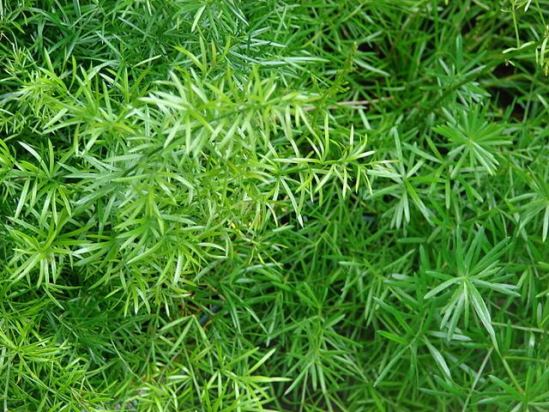

3.3. Asparagus Meyer - Asparagus Meyeri
Valuable decorative leafy perennial evergreen herb, reaching a height of 90 cm, grows slowly. Adult specimens form large, spreading "shrubs", consisting of numerous curved, pointed branches of a rounded shape, resembling the tentacles of an octopus. The leaves are acicular, tiny, light green. The flowers are fragrant, small, often go unnoticed inside the branches. The berries are small, rounded, and turn red when ripe.
↑ Up,
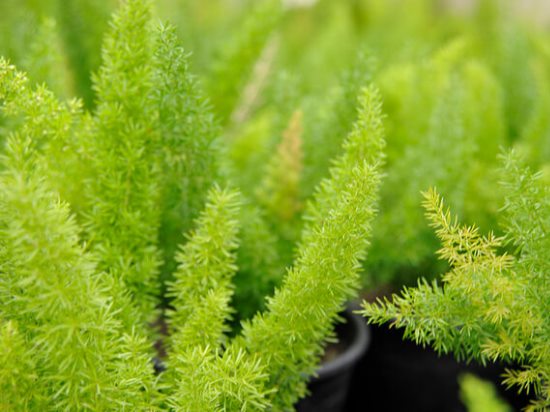

3.4. Asparagus sickle -Asparagus falcatus
An evergreen herb with numerous thin, flexible, green shoots. The stems can reach a length of 7 m, droop with age, which allows you to grow this species as an attractive ampelous plant. The leaves are narrow, glossy, green, whole-edged, up to 8 cm long. The flowers are delicate, white, small, collected in loose branched brushes and have a pleasant aroma. Fruits are red, rounded berries with a single black seed.
↑ Up,
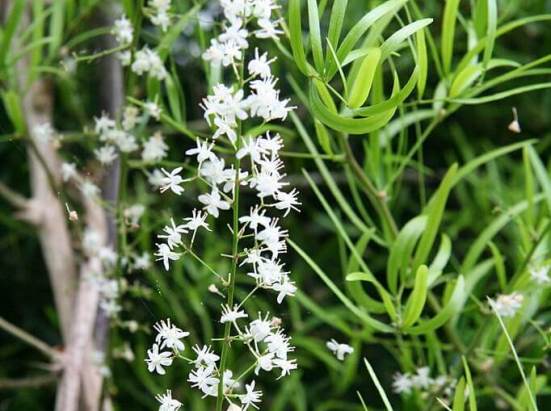

3.5. Asparagus Umbellatus or umbrella - Asparagus umbellatus
Plants with thick, tough, erect shoots 40 to 65 cm high. Each stem of this species bears thin twigs, on which are located long, emerald, curved, thin phylloclades, collected in whorls and resembling an umbrella. The flowers are small, greenish. Fruits - berries, when ripe, acquire an orange tint.
When and how it blooms
In the apartment, Sprenger's asparagus blooms often and abundantly, it is enough to provide him with good care.


Asparagus blooms
Types of flowers
The flowers that appear on the branches can be both male and female. The flowers are small, milky-peach colored.
Flower shapes
Small flowers are not singly located on the branches - they gather in axillary paniculate inflorescences.
Flowering period
The flowering period lasts a long time. The first inflorescences appear in late spring or early summer. Flowering usually ends in autumn.
Pruning
Asparagus pruning is done for several purposes:
- eliminate damaged diseased branches;
- make the bush thicker.
The peculiarity of this flower is that the cut branches will no longer grow in length. In this case, the growth of dormant buds at the base of the bush is activated.
Photo gallery
| Root system | Fibrous |
| Stem | Thickened |
| Leaf shape | Scaly, prickly |
| Leaf color | Green |
| Flower shape | Lily |
| Color of flowers | White |
| Fruit shape | Rounded |
| Fruit color | Bluish green |
| The number of seeds in the fruit | 3 |
Main characteristics of asparagus
This is a perennial plant that lives in houses for up to 10 years, but after 3-4 years it becomes less decorative. It is characterized by intense growth and gives long shoots that look equally good in hanging pots, in floor vases, and for decorating walls.
It is almost impossible to achieve flowering of asparagus indoors.And if this happens, then by 5-6 years small white flowers appear, forming inflorescences of 2-4 pieces on the upper part of the shoots. After flowering, bright red berries appear, which in no case should be eaten by people and animals, as they cause upset stomach mucosa and food poisoning.
The beneficial properties of asparagus
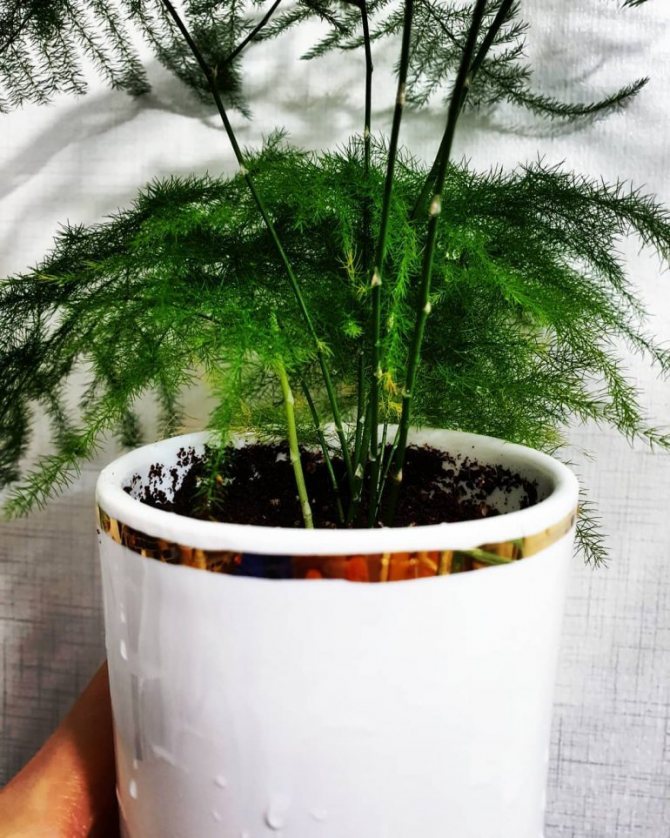

The most studied, for use as a medical raw material, is pharmacy asparagus, it is often used in folk medicine for:
- relief of migraine attacks;
- treatment of inflammatory processes in the urinary system;
- lowering blood pressure;
- elimination of cholesterol, toxins and harmful toxins from the body.
Asparagus also contains many vitamins, amino acids and mineral salts.
General information
The Asparagus flower (asparagus) belongs to the asparagus family. It has several hundred species, among which rhizome grasses predominate, dwarf shrubs and even lianas are found. The main distribution area is the tropical part of America, Africa, Asia. Representatives of asparagus can adapt to different climatic conditions, so today they are found everywhere. Some of them are edible and cultivated as agricultural plants.
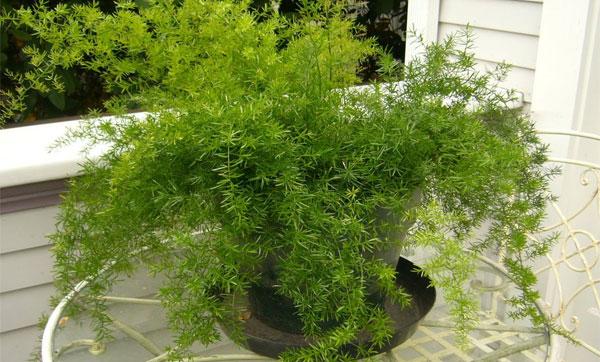

The houseplant asparagus outwardly distantly resembles a fern. Herbaceous shoots, branched, elastic. The leaves are underdeveloped, scaly. In their sinuses sit needle-shaped branched branches, often collected in bunches - cladodia. In indoor conditions, the plant rarely blooms. Small flowers of white, pale pink or cream color are collected in the axils of the leaves in small inflorescences; in some species, they are located singly. They have a delicate pleasant aroma. Asparagus berries are poisonous.
Home care
Asparagus requires minimal maintenance. Pay attention to watering and spraying.
Watering
In order for asparagus to develop a lush crown, follow the watering rules:
- use settled water that does not contain chlorine compounds;
- the water temperature must be at least +20 ° С;
- watering by adding water to the pan, and not at the root;
- in the heat, spray the branches daily.
If there is enough space, flowerpots with pallets can be placed in a shallow container filled with wet perlite or gravel. This technique allows you to increase the humidity around the plant.
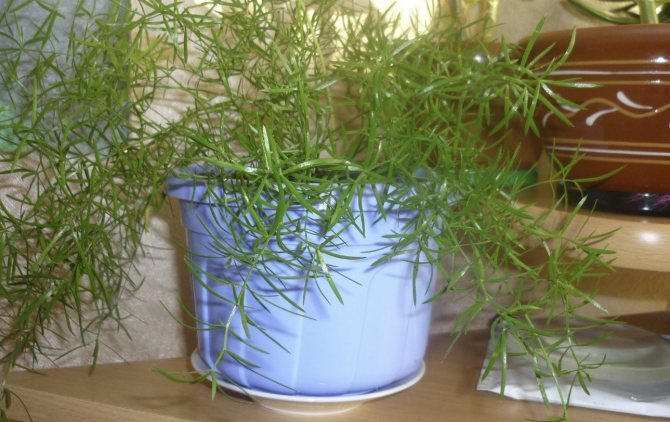

Top dressing
Apply fertilizers from early March to October once a month. Use mineral complex fertilizers for indoor flowers and organics, alternating between them. For example, in March, add mineral compounds, in April - horn shavings.
Elements that should be present in a complex fertilizer for asparagus:
- nitrogen;
- potassium;
- magnesium;
- calcium.
Find out in more detail how and how to feed indoor plants at home.
Pruning
For asparagus, there are 2 types of pruning:
- Formative - helps to model the shape of the bush and accelerate the development of new shoots.
- Sanitary - involves the removal of bald, dried out branches affected by diseases or pests.


When forming pruning, part of the shoots is shortened to the required length. They stop growing and new shoots are formed from the root system. Carry out such manipulations in the spring, before the first feeding. Sanitary pruning is permissible at any time of the year. Cut the shoots at the very root.
Transfer
Asparagus is a fast-growing ampelous plant, therefore it requires frequent transplantation. Up to 3 years old, plants dive annually. Adult specimens are transplanted every 2 years. Perform these procedures in the spring, in March-April.
Pick up pots deep and spacious. For full development, plants require loose soil with a neutral pH - in the range of 5.5–7.You can use a store-bought universal soil for decorative deciduous plants, adding 20% vermiculite or perlite to it, or mix the soil yourself, combining in equal parts:
- sand;
- peat;
- leafy sod soil;
- clay-sod soil.
Video: Asparagus Transplant
Disinfect the earth with Fitoverm (according to the instructions attached to the preparation). Transplant using the transshipment method:
- Water the plants abundantly 12 hours before transplanting. This makes it easier to remove the roots from the pot.
- After preparing a new pot, fill it with expanded clay, then lay a layer of soil. The container should be about 1/3 full.
- Tilt the pot with the plant with one hand slightly downward, and with the other, dig into the ground and remove the contents. If there are overgrown roots, they must be removed.
- Place the plant in a new pot and cover with soil.
- After slightly compacting and moistening the soil, send the pots to a room with dim lighting for several days.
- After a week, the asparagus can be placed in its permanent place.
Important! When buying an adult plant in the store, do not put it directly next to the greenery already in the house. First, carry out the treatment with Actellic
» (according to the instructions), transplant into another container, completely replacing the earthen lump. After a week, you can put a new one
«
resident
»
to a permanent place. This will help protect your home garden from the spread of pests and diseases.
Transfer
Young shrubs are planted in small pots and transplanted into larger containers each year. When the plants grow up, the procedure is carried out once every 3 years.
An asparagus transplant is performed as follows:
- Water the bush so that it can be easily removed from the container.
- Turn the pot over, gently shake out the root system along with a lump of earth.
- Examine the roots, if necessary, remove rotten and dry ones.
- A new pot is filled by a third with earth, an asparagus is placed in the center, covered with a substrate, and watered.
Important! When transplanting, the asparagus shoots must not be buried: they must remain at the same level.
Pests, diseases
Like other crops, asparagus have their own "enemies" - pests, insects, infections. However, at home, improper care is often the “enemy”. It is advisable to familiarize yourself in advance with the list of symptoms that should alert the grower.
| Signs | The reasons | Prevention and treatment |
| Turns yellow, begins to crumble. | Too hot, dry. In winter, this is possible due to a lack of light or vitamins. | Water on time, do not "fill", the soil should be moistened, take care of vitamins and the presence of light. |
| The stem stretches out and turns pale. | Little light or excess nitrogen fertilizer. | Improve lighting, temporarily stop using nitrogen fertilizers. |
| On the edges of the shoots, brownish specks. | Burn. | Remove from the sun - move away from the window, curtain the window with tulle. |
| Growing slowly or not growing at all. | Lack of dressings, nutrients. | Consult with specialists, fertilize and feed on time. |
| The plant on the street falls off cladodes. | The temperature outside is too low (possibly dropped sharply). | Bring it into the room (it is better if it is up to + 15 ° C) and cut off the top of the plant. |
| The shoots have wilted and dries up. | Root rot due to excess water. | Remove from the pot, cut off the rotten tubers, treat the soil and roots with the antifungal agent Gamair or Discorm. |
| Pronounced yellowness. | Scale insect pest. | Spray with Aktellik (2 ml / 1 l of water), rinse off the shield in the shower. |
| The plant will turn yellow and wither. | A spider mite that feeds on stem juices, cladoniums, etc. | Treatment of the initial stage - treatment with a solution of household soap, prevention - normal humidity in the room. |
| Discolored shoots, stunted growth. | Thrips - due to dry air and waterlogged soil. | Spray with Actellik or Decis insecticide. Bring temperature and humidity back to normal. |
Diseases, pests and growing problems
This plant, despite its origin and the presence of a considerable number of garden fellows, is very unstable to pests. Indoor asparagus often suffer from spider mites, thrips, felt, but, as a rule, they all appear only in the absence of spraying and showering.
Plants can be especially badly affected by spider mites, when infested, it is better to place asparagus under a hood or in very high air humidity to optimize control measures for this pest.
More often, ornamental asparagus simply loses its leaves in winter - from dry air, too high temperatures and poor lighting. All plant problems are associated with the care and selection of conditions of detention, and very rarely - with diseases.
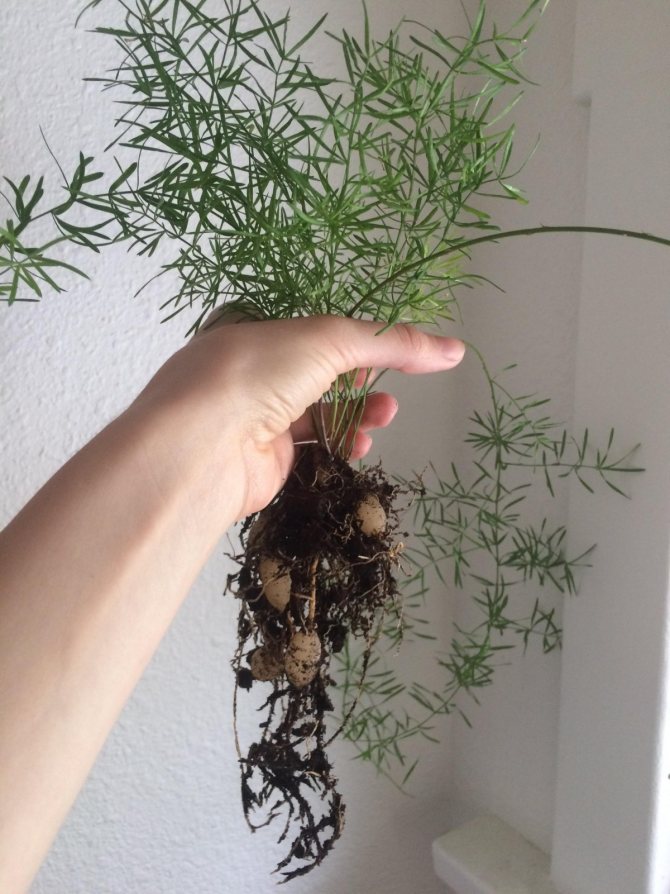

It is very easy to propagate Sprenger's asparagus by dividing adult bushes into parts.
Possible growing difficulties
When growing asparagus, you can face the following difficulties:
- fungal diseases - if any type of rot appears, it is necessary to remove the damaged parts of the plant, carry out a transplant with a complete replacement of the earthen coma and a disinfection bath for the roots;
- scale insect and spider mite - insects are removed first by hand, then they are treated with Fitoverm.
Did you know? Ardent French people confess their love to women, presenting a bouquet containing asparagus as a gift, or depicting these plants on postcards or gift wrappers. Such a gesture speaks of high feelings, sincere admiration for the charm of a woman.
Asparagus sprenger is an unpretentious houseplant that will be an excellent interior decoration. Even a beginner can handle its cultivation.
Growing Sprengeri from seeds
Sprenger's Asparagus grows remarkably from seed... They can be purchased from a store or obtained by yourself. Once the plant has bloomed and red berries appear, it's time to harvest. After harvesting, they must be kept in a dry place to maintain germination for several years.
Pot selection
For planting, you need to choose wide pots, because asparagus has an actively developed rhizome. It consists of nodules, which, as they grow, accumulate the necessary supply of nutrients.
The soil
For the correct cultivation of Sprenger's asparagus, a loose, breathable soil with a good nutritional base and neutral acidity is necessary. You can buy it at the store. Suitable for universal soil for deciduous and decorative flowers... You need to add vermiculite and a little perlite to it.
Step-by-step instruction
Sow seeds, preferably immediately after harvest., February is considered the ideal time.
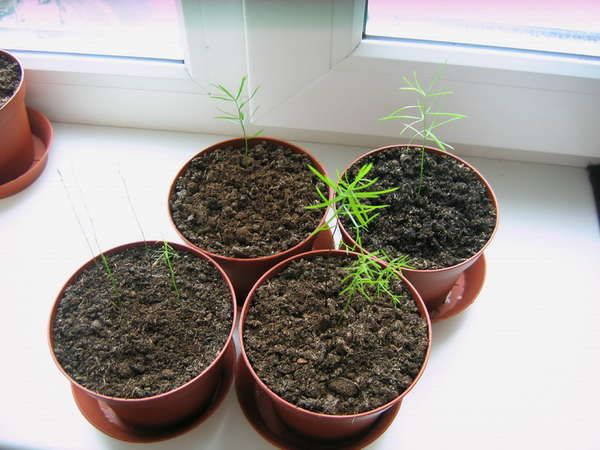

- A good drainage layer is laid at the bottom of the pot. Pebbles, expanded clay, fragments from clay pots, pieces of foam plastic can be used as drainage.
- Then the prepared soil is poured and the seeds are placed in it.
- The peat-sand mixture should be slightly moistened. You can spray the ground with a spray bottle.
- Create a greenhouse by covering the pot with glass or a plastic bag.
- It is advisable to place the pot in a room with a temperature of about 21 degrees.
- Every day it is necessary to moisten and ventilate the planted plant.
In one month, the seedlings will hatch, when they reach ten centimeters, they recommend diving... Already in summer, young plants should be planted in separate pots with soil for adult plants.
Next, watch a video on how the process of growing from seeds looks like in practice:
Testimonials
after transplantation, it is better to put asparagus in a darker place, it does not welcome bright sunlight. But I am sure that he will adapt and will not get sick. I keep asparagus on a shelf 3 meters from the window, it is sufficiently lit, but direct sunlight does not fall.I can't stand it on the balcony, as it fades, the leaves become pale. By the way, he loves feeding very much. I often do foliar dressing with Agricola for Tomatoes.
irishka
Asparagus care
It's easy to look after him. He is unpretentious. It is enough to adhere to simple recommendations.
Creation of temperature and humidity conditions is the key to the health of asparagus. It does not tolerate dry air well.
Small difficulty in caring for him - he grows long shoots (1.5-2 meters). Sometimes their length reaches 3 meters.
Let's start the conversation with the necessary lighting requirements.
Lighting requirements
The preferred place for it is window sills facing the west and east sides or a separate stand inside the room. Although he adapts to the existence on the north side. But it is not recommended to place it on the southern windows, especially if there is nothing to shade it with.
The flower needs sufficient lighting, but it does not like sunny places. Delicate leaves can burn.
It feels great in shaded areas. Therefore, it is often placed in hallways, corridors, bathrooms. A sufficient light source is fluorescent lamps, turned on for 14-16 hours a day.
In low light conditions, foliage takes on a lighter shade of green.
In warm weather, asparagus will love being outside. But do not leave it in sunlit areas (especially for a long time). He needs gradual acclimatization over 2-3 weeks. It painfully endures the abrupt change from indoor to outdoor living.
In winter, it does not need additional lighting. The absence of artificial lighting makes it easy to care for.
The temperature required for asparagus
This plant tolerates a fairly wide temperature range well. He is most comfortable at 20-24 ° C. Calmly tolerates a temperature rise of up to 30 ° C with increased watering. The winter minimum is 13 ° C. At this time, asparagus feels good at a temperature of 15-18 ° C. Keeping at high temperatures leads to exposure and drying of the stems.
Helpful advice. It is enough to cut off bare and dry stems, reduce watering. New shoots will appear soon. Then watering is increased.
However, like any indoor flower, it should be protected from hypothermia in winter and from the hot sun in summer.
A drop in temperature affects its growth and general development.
Watering, moisture, feeding
Asparagus loves watering. It should be watered as the soil dries out, preventing the top layer from drying out. Although he endures this moment courageously, he simply throws off his needle-like leaves. But these periods should not be too long.
You can water from the pallet, just make sure that the water does not stagnate in it. The average watering schedule is about 2 times a week.
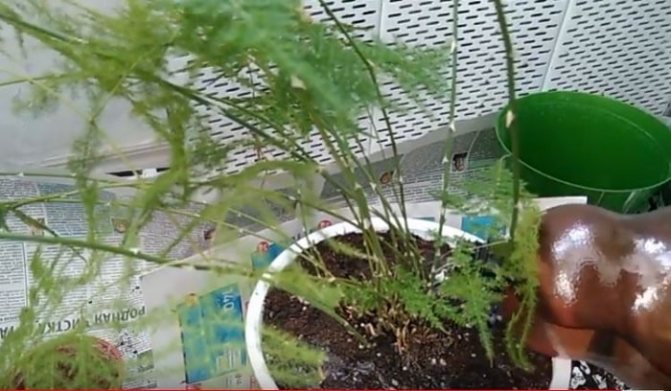

Watering
Spraying is carried out in the morning. However, it is not a mandatory procedure in the care of asparagus.
He likes occasional light bathing in the bathroom. But not with a direct stream from the shower, but from a sprayer. With this procedure, all dust is removed from the leaves. Use the method of immersion in a basin of water for irrigation for 30 minutes. During this time, the soil is saturated with moisture.
From November to February, watering is reduced. They are becoming more economical. It is important to ensure that the soil does not dry out completely.
From the observations of florists it is known:
- If the plant is placed near heating devices, then small leaves begin to crumble and turn yellow. You will have to rearrange it away from the dry air source.
- If it looks brown and sluggish, then it needs more water.
Asparagus responds well to feeding - it immediately gives new shoots. Sometimes one procedure is enough for this. Any complex fertilizer is suitable. They are used during the period of active growth.
He needs fertilizing with nitrogen and iron content.Suitable liquid universal fertilizers with a concentration reduced by half from that indicated in the instructions, and organic (slurry, vermicompost).
Regularity of the procedure:
- during the period of active growth - once every 1-2 weeks;
- at other times - monthly;
- in winter, feeding is stopped.
Top dressing is carried out only after abundant watering in order to protect delicate roots from burns.
Benefit and harm
Admirers of Indian culture and Feng Shui talk about the amazing properties of this plant. It is believed that it is able to absorb bad energy and cleanse the aura of negative emotions. In addition, asparagus perfectly cleanses and humidifies the air in the apartment.
ATTENTION: Please note that the berries of the plant are poisonous. Keep the plant away from pets and children!
Asparagus is a supplier of vitamins and nutrients in early spring when other vegetables are still in short supply. You may be interested in reading articles about Sprenger's asparagus, a white and medicinal variety of asparagus.
Description and photo of the species
Sprenger's Asparagus, or Ethiopsian Asparagus, is one of the most popular species of this evergreen perennial. It is placed in apartments, offices and offices, winter gardens.
Get acquainted with the intricacies of caring for such indoor plants as torenia, ktenanta, kufeya, syngonium, gloriosa, ripsalis, columnea, pittosporum, xanthosome, aucuba, ginura, hemantus.
Thick creeping branches are covered with fluffy cladodes, grow to the sides and reach 1.5 meters in length... False leaves of a pale green color cover the shoots along the entire length, most of them are collected in bunches of 3-4 pieces, which gives Sprenger's asparagus a high decorative effect.


Flowering time - May, June. Bunches of miniature white flowers have a delicate, pleasant aroma. As a result of pollination, small round red berries are formed and ripen. Sprenger's asparagus fruits are suitable for growing from seeds of new plants.
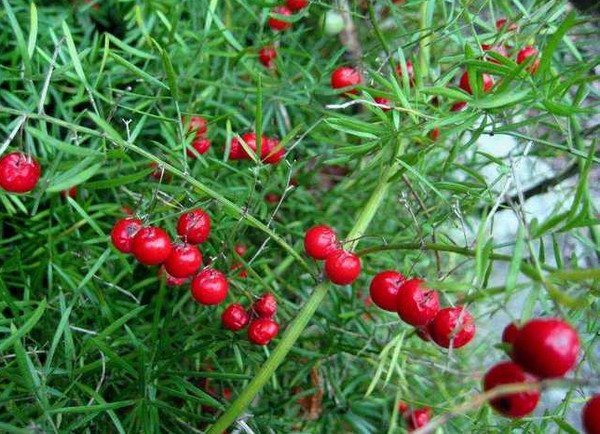

Did you know? A peculiarity of the genus is that the real leaves are very miniature, and instead of them, the plant is covered with cladodia - modified stems that look like soft needles that perform the functions of leaves.
Why does asparagus turn yellow?
Common causes of yellowness:
- low or high substrate moisture;
- improper lighting;
- burns;
- dry indoor air;
- too small pot;
- nutritional deficiencies;
- severe parasite infestation or advanced diseases.
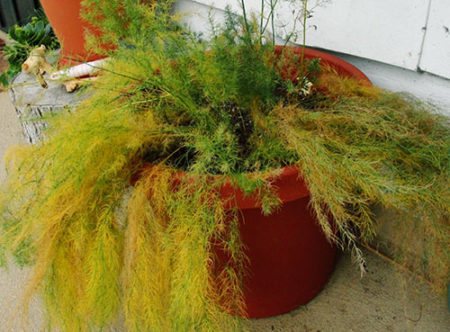

If the plant turns yellow, try to find the cause and fix it. General measures are increasing air humidity, organizing proper watering and lighting, applying fertilizers on schedule and transplanting a flower on time.
Cooking applications
Asparagus - types and care at home
Young shoots of asparagus are used in cooking. They can be of different colors: white, purple, pink or green. Vegetable culture brings many benefits, it contains a large amount of useful trace elements, folic acid, selenium, choline, niacin, vitamins C, K, E, A, B.
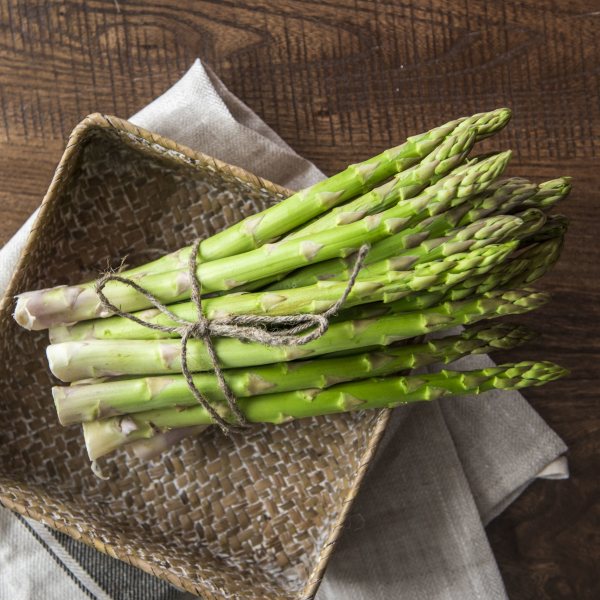

Asparagus is found in many recipes
Young shoots are taken for cooking. You can perform any culinary manipulations with them: canning, baking, frying, stewing, boiling. Asparagus is excellent for preparing side dishes, cooking soups, and making desserts. It goes well with meat, game, poultry, fish and seafood.
Important! Asparagus is one of the most expensive vegetable crops.
How to reproduce?
There are 3 main ways of breeding asparagus: propagation by seeds, cuttings and division.
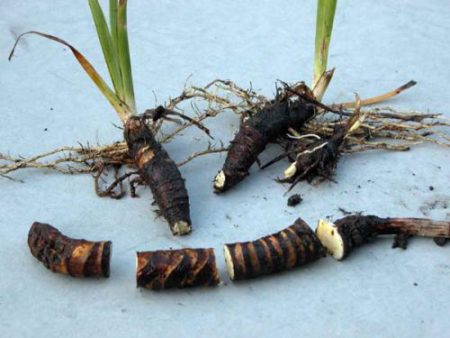

- Seeds. This method is more natural and safer for the mother plant. After receiving the seeds, plant them in the container with the nutrient mixture and cover with plastic wrap. After a while, shoots will appear.Grown asparagus seeds must be planted in separate containers.
- Cuttings. A compromise breeding method. Allows to keep the mother plant relatively intact. The shoots take root more often than shoots obtained with the help of seeds. Only large stems (at least 10 cm in length) with several growth points are suitable for reproduction. After separating the plant, treat the cuts with charcoal or cinnamon, then place the future shoots in a greenhouse for young asparagus and ventilate regularly. Repot the shoots only after the leaves appear.
- Division. The most reliable method. Bushes often take root even if the rhizome had to be cut lengthwise.
The seeds are used by advanced growers to produce a large number of shoots. This is necessary for industrial breeding or for making bouquets. Beginners most often prefer to divide the bushes. Cutting less damages the mother plant, but you have to wait a long time for the shoots to appear (at least 6 weeks).
Asparagus of the finest, feathery, common, racemose, densely flowered species, video
Asparagus or asparagus is a large genus in the family of the same name, Asparagaceae. At the last count, botanists have discovered and described about three hundred species of plants of this genus, and among them there are edible, medicinal, and ornamental varieties. Most of the asparagus species are perennial plants that look like shrubs and semi-shrubs, lianas and ampelous crops.
Under the name "asparagus", common or pharmaceutical asparagus, which is grown as an early ripening vegetable crop, is widely known in the world. But a much larger number of varieties were cultivated due to the extraordinary openwork foliage. Today, decorative leafy asparagus species are used in landscaping interiors and gardens around the planet.
At home, asparagus have shown themselves to be undemanding plants in terms of care and living conditions, willingly growing and blooming in apartments. There are several most popular indoor types.
Asparagus asparagus was first described and classified by K. Linnaeus in 1753, but the culture began to belong to the genus of asparagus only in 1909. Indeed, this indigenous inhabitant of southern and eastern Africa does not resemble its more famous relatives.
The graceful asparagus asparagus is a herbaceous vine with stems up to three meters long. Phyloclades, sometimes called leaves, but in fact are the stems of a plant, pointed lanceolate, smooth, shiny. The width of such a "sheet" is 2 cm, the length is twice that.
On wild specimens, flowers, as in the photo of asparagus, appear from July to September. They are small with a noticeable aroma. After pollination, in their place, first green, and then red-carmine berries are tied.
Among flower growers, you can hear another name for the plant - asparagus medioloides, and in the homeland of the culture, as well as in Australia and New Zealand, which has become its second homeland, the vine is called wedding or veil. The reason is that the overgrown plant creates a beautiful openwork curtain, reminiscent of a bride's veil.
Despite its popularity in Australia, this creeping asparagus species is officially recognized as a serious agricultural hazard.
An extremely common and beloved species of asparagus, which is a perennial, evergreen plant, which, depending on the variety and variety, can serve as a ground cover or pot culture. Plants easily tolerate bright sun and, as befits people from South Africa, have small thorns.
Asparagus densiflorus grows in coastal areas and in the province of KwaZulu-Natal in southern Africa. The plant is resistant to drought, undemanding to the composition of the soil, but more readily grows and blooms in moist soil rich in organic matter.
The type of plant varies greatly depending on the cultivar and subspecies. In most plants, the stems reach a meter in length and can be either erect or drooping, like the dense-flowered asparagus Sprenger. It is the most popular of the densiflorus species.
In place of flowers after pollination, spectacular bright red berries appear, as in the photo of asparagus, containing one black seed in ripe form.
Asparagus dense-flowered Sprenger in the wild and when grown in the garden is a groundcover. In a pot culture, young shoots first keep a vertical shape, then, reaching a length of about a meter, they droop. The plant grows well in the sun, when it gets into the shade, the stems stretch out, and the greens become whiter, thinner.
Phylloclades of this asparagus species do not exceed 2–2.5 cm in length, and their width is only 1–2 mm. The stems are grouped. In spring, white or pinkish flowers appear on asparagus.
The root system is very ramified and consists of thin roots and bulbous tubers with which the plant can be propagated.
This pictured asparagus looks best when grown in shade or partial shade. The asparagus densiflorus of the Meyersii variety is known by various names, but most commonly the plant is referred to as foxtail fern, asparagus fern or Meyers asparagus.
The height of this representative of asparagus reaches 60 cm, while the bush consists of long soft stems emanating from a common center.
The bush remains compact for a long time and is very decorative and appreciated by florists.
Densely pubescent shoots are covered with thin soft needles of a light green hue, which gives the stem the appearance of a cat's or fox's tail. Flowers are small, white. Fruits are round, bright red berries.
In the wild, Meyers' asparagus can be found in southern Africa and Mozambique.
This is the only variety for which the sun is contraindicated, and the plant reveals its decorative effect better in light shade.
Native to Mozambique and South Africa, it is one of the largest asparagus species on the planet. At home, in South Africa, the planting of crescent asparagus is designed to protect the borders of land plots.
And this role of the plant is not surprising, because this type of asparagus forms long branched shoots up to 7 meters high.
When making a support, young, still grassy shoots entwine it and eventually turn into a solid hedge crowned with thorns.
This type of asparagus has a high growth rate and can be grown both in the shade and in dim sun. The plant is good for watering, reproduces both by seeds and by dividing an adult bush.
Asparagus racemose or racemosus is native to Nepal, India and Sri Lanka. Here the plant is well known as satavar or shatavari.
The plant reaches a height of one to two meters and in natural conditions prefers to root in soils with a lot of rocks, gravel and large inclusions. In botany, the asparagus species was described in 1799 and since then has not lost its popularity, and even finds new admirers not only as an ornamental plant, but also as a green healer.
The appearance of the shrub is very decorative. This plant is up to two meters high with climbing or drooping shoots with subulate cladodia collected in bunches. Asparagus got its official name due to the pinkish or white flowers collected in a brush with a bright aroma.
Asparagus pinnate is native to South Africa, but the plant turned out to be so unpretentious that it easily acclimatized in other parts of the world.
The name of this asparagus comes from the Latin Saeta, which means "hair" or "bristles". Therefore, the species is sometimes called the finest asparagus or bristly. Another version of the name, A.
plumosus or feathery, obtained by the plant as early as 1875, is considered obsolete.
The plant is a climbing shrub with bare, strongly branching stems emanating from a common center of growth. The areas of the stem, called leaves, are indeed the thinnest of all the varieties studied. The bundle contains 3–12 phylloclades, up to 15 mm long and up to 0.5 mm in diameter.
The flowering of the asparagus shown in the photo consists of the appearance of many small white flowers. The fruits, unlike other described asparagus species, are not red, but blue-black, containing from 1 to 3 seeds.
about asparagus
How to care depending on the season (table)
| Season | Lighting | Temperature | Humidity |
| Spring | The plant is light-loving, but the sun's rays can leave a burn on delicate shoots. If you want to place the asparagus on the windowsill, then you need to choose the northwest or northeast window. The western or eastern direction implies shading with a light tulle curtain. And if your windows face south, then the flower should be placed at some distance from the window. But don't place the asparagus in the shade. Lack of light will negatively affect young shoots, they will begin to stretch and stop branching. In summer it grows well on a balcony, loggia or garden, but in light partial shade. | In the warm season, it feels quite comfortable at an ordinary room temperature of 18 to 24 ° C. | In general, the plant is normal to the natural humidity in the room. But if it is very hot, the dry air can interfere with normal flowering. Cladodes may also begin to turn yellow. To remedy the situation, the pot with the plant can be placed on a pallet with moistened pebbles. It is imperative to spray during such periods. |
| Summer | |||
| Fall | In winter, be sure to rearrange the plant closer to the window so that it receives more light. | In winter, it rather needs a cool room. Temperature 14 - 16 ° C. The plant has a very negative attitude towards sharp increases in temperature in summer and a decrease in winter. The only exception is sickle-shaped asparagus. | During the heating season, spraying should be carried out regularly with warm water. But if the plant is kept in a cool room, then there is no need for the procedure. |
| Winter |
In summer, you can put asparagus under the shower, it is so easy to wash off the dust from the shoots.
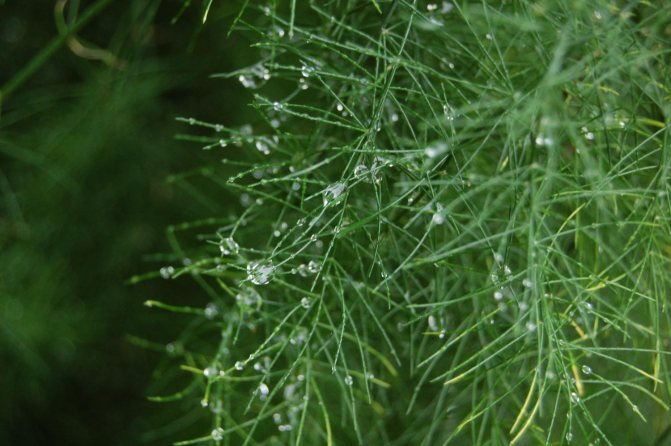

In summer, asparagus is very fond of taking a shower.

